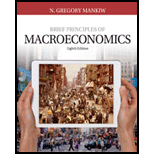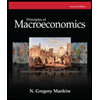
Subpart (a):
The Investment and the loanable fund market of the economy.
Subpart (a):
Explanation of Solution
Investment is an asset or an item purchased today in the hope that it will generate income in the future. In that sense, the spending of capital on the purchase of new physical capitals refers to the equipment and the buildings and so forth.
When there is no possibility of loanable fund market between the students and each have to invest their own amounts, then each of the students will have the following returns after one year:
Thus, Harry will have $1,050 after one year. Similarly, the returns of Ron and Hermione can be calculated as follows:
Thus, Ron will have $1,080 after one year.
Thus, Hermione will have $1,200 after one year.
Concept introduction:
Investment: It is an asset or an item purchased today in the hope that it will generate income in the future.
Subpart (b):
The Investment and the loanable fund market of the economy.
Subpart (b):
Explanation of Solution
When there is a loanable fund market between the students at the rate of interest 'r', each student will compare the rate of their return with the rate of interest in the loanable fund market for loanable funds, which is 'r'. When the rate of returns is higher than the rate of interest, the student would borrow and if it is lower than the interest rate, then the student will lend.
Concept introduction:
Investment: It is an asset or an item purchased today in the hope that it will generate income in the future.
Subpart (c):
The Investment and the loanable fund market of the economy.
Subpart (c):
Explanation of Solution
When the rate of interest is 7 percent, Harry would want to lend the money with him because when he compares the
When the rate of interest increases to 10 percent, both Harry and Ron would turn out to be lenders because their rate of return is lower than the rate of interest but Hermione would still be the borrower, since the rate of return is higher than the rate of interest. Here, the quantity of loanable funds demanded is $1,000 and quantity of loanable funds supplied is $2,000.
Concept introduction:
Investment: It is an asset or an item purchased today in the hope that it will generate income in the future.
Subpart (d):
The Investment and the loanable fund market of the economy.
Subpart (d):
Explanation of Solution
The loanable fund market will be in equilibrium when the quantity of loanable funds demanded and supplied in the market becomes equal. At 8 percent rate of interest, Harry would like to lend and Hermione would like to borrow. Ron would use his own savings to invest because the rate of interest and rate of return to him is equal and he would not like to lend or borrow. Thus, the quantity of loanable fund supplied will become $1,000 by Harry and that which was demanded will also become $1,000 by Hermione. This would make the loanable fund
Concept introduction:
Investment: It is an asset or an item purchased today in the hope that it will generate income in the future.
Subpart (e):
The Investment and the loanable fund market of the economy.
Subpart (e):
Explanation of Solution
When the rate of interest in the economy is 8 percent, Ron will use his own capital stock and Harry would lend the amount with him. Thus, both of them will earn the same rate of return which is 8 percent. This can be calculated as follows:
Thus, both of them would earn $1,080. So, the lender Harry would earn $30 higher than without lending a return to him. In the case of Hermione, he will borrow $1,000 from Harry and would invest but he has to repay the $1,000 and its 8 percent interest to Ron. Thus, the returns to Hermione can be calculated as follows:
Thus, Hermione will have a return of $1,320 which is $120 higher than no loanable fund market. Thus, since the borrower and lender are better off in the economy, no one is worse off.
Concept introduction:
Investment: It is an asset or an item purchased today in the hope that it will generate income in the future.
Want to see more full solutions like this?
Chapter 13 Solutions
MindTap Economics, 1 term (6 months) Printed Access Card for Mankiw's Principles of Macroeconomics, 8th (MindTap Course List)
- 2. What is the payoff from a long futures position where you are obligated to buy at the contract price? What is the payoff from a short futures position where you are obligated to sell at the contract price?? Draw the payoff diagram for each position. Payoff from Futures Contract F=$50.85 S1 Long $100 $95 $90 $85 $80 $75 $70 $65 $60 $55 $50.85 $50 $45 $40 $35 $30 $25 Shortarrow_forward3. Consider a call on the same underlier (Cisco). The strike is $50.85, which is the forward price. The owner of the call has the choice or option to buy at the strike. They get to see the market price S1 before they decide. We assume they are rational. What is the payoff from owning (also known as being long) the call? What is the payoff from selling (also known as being short) the call? Payoff from Call with Strike of k=$50.85 S1 Long $100 $95 $90 $85 $80 $75 $70 $65 $60 $55 $50.85 $50 $45 $40 $35 $30 $25 Shortarrow_forward4. Consider a put on the same underlier (Cisco). The strike is $50.85, which is the forward price. The owner of the call has the choice or option to buy at the strike. They get to see the market price S1 before they decide. We assume they are rational. What is the payoff from owning (also known as being long) the put? What is the payoff from selling (also known as being short) the put? Payoff from Put with Strike of k=$50.85 S1 Long $100 $95 $90 $85 $80 $75 $70 $65 $60 $55 $50.85 $50 $45 $40 $35 $30 $25 Shortarrow_forward
- The following table provides information on two technology companies, IBM and Cisco. Use the data to answer the following questions. Company IBM Cisco Systems Stock Price Dividend (trailing 12 months) $150.00 $50.00 $7.00 Dividend (next 12 months) $7.35 Dividend Growth 5.0% $2.00 $2.15 7.5% 1. You buy a futures contract instead of purchasing Cisco stock at $50. What is the one-year futures price, assuming the risk-free interest rate is 6%? Remember to adjust the futures price for the dividend of $2.15.arrow_forward5. Consider a one-year European-style call option on Cisco stock. The strike is $50.85, which is the forward price. The risk-free interest rate is 6%. Assume the stock price either doubles or halves each period. The price movement corresponds to u = 2 and d = ½ = 1/u. S1 = $100 Call payoff= SO = $50 S1 = $25 Call payoff= What is the call payoff for $1 = $100? What is the call payoff for S1 = $25?arrow_forwardMC The diagram shows a pharmaceutical firm's demand curve and marginal cost curve for a new heart medication for which the firm holds a 20-year patent on its production. Assume this pharmaceutical firm charges a single price for its drug. At its profit-maximizing level of output, it will generate a total profit represented by OA. areas J+K. B. areas F+I+H+G+J+K OC. areas E+F+I+H+G. D. - it is not possible to determine with the informatio OE. the sum of areas A through K. (...) Po P1 Price F P2 E H 0 G B Q MR D ōarrow_forward
- Price Quantity $26 0 The marketing department of $24 20,000 Johnny Rockabilly's record company $22 40,000 has determined that the demand for his $20 60,000 latest CD is given in the table at right. $18 80,000 $16 100,000 $14 120,000 The record company's costs consist of a $240,000 fixed cost of recording the CD, an $8 per CD variable cost of producing and distributing the CD, plus the cost of paying Johnny for his creative talent. The company is considering two plans for paying Johnny. Plan 1: Johnny receives a zero fixed recording fee and a $4 per CD royalty for each CD that is sold. Plan 2: Johnny receives a $400,000 fixed recording fee and zero royalty per CD sold. Under either plan, the record company will choose the price of Johnny's CD so as to maximize its (the record company's) profit. The record company's profit is the revenues minus costs, where the costs include the costs of production, distribution, and the payment made to Johnny. Johnny's payment will be be under plan 2 as…arrow_forwardWhich of the following is the best example of perfect price discrimination? A. Universities give entry scholarships to poorer students. B. Students pay lower prices at the local theatre. ○ C. A hotel charges for its rooms according to the number of days left before the check-in date. ○ D. People who collect the mail coupons get discounts at the local food store. ○ E. An airline offers a discount to students.arrow_forwardConsider the figure at the right. The profit of the single-price monopolist OA. is shown by area D+H+I+F+A. B. is shown by area A+I+F. OC. is shown by area D + H. ○ D. is zero. ○ E. cannot be calculated or shown with just the information given in the graph. (C) Price ($) B C D H FIG шо E MC ATC A MR D = AR Quantityarrow_forward
- Consider the figure. A perfectly price-discriminating monopolist will produce ○ A. 162 units and charge a price equal to $69. ○ B. 356 units and charge a price equal to $52 for the last unit sold only. OC. 162 units and charge a price equal to $52. OD. 356 units and charge a price equal to the perfectly competitive price. Dollars per Unit $69 $52 MR 162 356 Output MC Darrow_forwardThe figure at right shows the demand line, marginal revenue line, and cost curves for a single-price monopolist. Now suppose the monopolist is able to charge a different price on each different unit sold. The profit-maximizing quantity for the monopolist is (Round your response to the nearest whole number.) The price charged for the last unit sold by this monopolist is $ (Round your response to the nearest dollar.) Price ($) 250 225- 200- The monopolist's profit is $ the nearest dollar.) (Round your response to MC 175- 150 ATC 125- 100- 75- 50- 25- 0- °- 0 20 40 60 MR 80 100 120 140 160 180 200 Quantityarrow_forwardThe diagram shows a pharmaceutical firm's demand curve and marginal cost curve for a new heart medication for which the firm holds a 20-year patent on its production. At its profit-maximizing level of output, it will generate a deadweight loss to society represented by what? A. There is no deadweight loss generated. B. Area H+I+J+K OC. Area H+I D. Area D + E ◇ E. It is not possible to determine with the information provided. (...) 0 Price 0 m H B GI A MR MC D Outparrow_forward
 Essentials of Economics (MindTap Course List)EconomicsISBN:9781337091992Author:N. Gregory MankiwPublisher:Cengage Learning
Essentials of Economics (MindTap Course List)EconomicsISBN:9781337091992Author:N. Gregory MankiwPublisher:Cengage Learning Brief Principles of Macroeconomics (MindTap Cours...EconomicsISBN:9781337091985Author:N. Gregory MankiwPublisher:Cengage Learning
Brief Principles of Macroeconomics (MindTap Cours...EconomicsISBN:9781337091985Author:N. Gregory MankiwPublisher:Cengage Learning Exploring EconomicsEconomicsISBN:9781544336329Author:Robert L. SextonPublisher:SAGE Publications, Inc
Exploring EconomicsEconomicsISBN:9781544336329Author:Robert L. SextonPublisher:SAGE Publications, Inc Principles of Economics (MindTap Course List)EconomicsISBN:9781305585126Author:N. Gregory MankiwPublisher:Cengage Learning
Principles of Economics (MindTap Course List)EconomicsISBN:9781305585126Author:N. Gregory MankiwPublisher:Cengage Learning Principles of Macroeconomics (MindTap Course List)EconomicsISBN:9781285165912Author:N. Gregory MankiwPublisher:Cengage Learning
Principles of Macroeconomics (MindTap Course List)EconomicsISBN:9781285165912Author:N. Gregory MankiwPublisher:Cengage Learning





